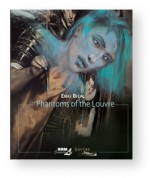
By Enki Bilal translated by Joe Johnson (NBM ComicsLit/Louvre: Musée du Louvre Éditions)
ISBN: 978-1-56163-841-3
A few years ago the legendary Louvre Museum in Paris began an intriguing and extremely rewarding collaboration with the world of comics, and their latest beguiling translated bande dessinée is now available in English courtesy of those fine folks at NBM.
Phantoms of the Louvre is a lush and beautiful, oversized hardback graphic art book which reproduces the stunning results of master storyteller Bilal’s creative response to the collected treasures and even architecture of the prestigious institution.
The origins and details of the project are described in his Preface and the 22 artworks which resulted had their own exhibition in the Louvre in 2013.
The premise is delightfully simple: each item and place in the galleries is blessed or afflicted by a ghost somehow attached to an item which affected their lives or passing, and Bilal incorporates a photo of each artefact with an image of the ghost.
The story of every phantom is then told in poetic prose augmented by photos, sketches and designs of the revenant in question…
Enes Bilalović AKA Enki Bilal was born in Belgrade in 1951, breaking into French comics in 1972 with Le Bal Maudit for Pilote. Throughout the 1970s he grew in skill and fame, and achieved English-language celebrity once his work began appearing in America’s Heavy Metal magazine.
Best known for his self-scripted Nikopol Trilogy (Gods in Chaos, The Woman Trap and Cold Equator) his other bleakly beguiling and ferociously contemplative works include Ship of Stone, The Town That Didn’t Exist, Exterminator 17, Four?, Magma, Julia & Roem and many, many more. In recent years Bilal returned to contemporary political themes with his much-lauded, self-penned Hatzfeld Tetralogy…
As always, the work is produced in close collaboration with the forward-looking authorities of the Musée du Louvre, but this is no gosh-wow, “Night-at-the-Museumâ€, thinly-concealed catalogue of contents from a stuffy edifice of public culture. Rather, here is a gripping, intense, informative and insightful glimpse into the power of art and history as engines of imagination and personal obsession.
Weaving fact into an imaginary tapestry of fictions detailing the putative lives of those affected by or affecting the creation of the inspirational treasures, the stunning procession of lost souls leads off with ‘Aloyisias Alevratos’ inspired by The Winged Victory of Samothrace, detailing an ancient sculptor’s history whilst ‘Antonio Di Aquila’ recounts the short, tragic life of one of Leonardo da Vinci’s assistants/models during the period when the master painted the Portrait of Lisa Gherardini, wife of Francesco Del Giocondo, called Mona Lisa, La Gioconda or La Joconde…
‘Enheduana Arwi-A’ was a remarkable woman who engraved part of the tablet containing The Code of Hammurabi whilst ‘Arjuna Asegaff’ turned a troubled life around to become a popular model who posed for Baron Pierre-Narcisse Guérin’s The return of Marcus Sextus and ‘Analia Avellaneda’ developed a new pigment which fascinated Doménikos Theotókopoulous, called “El Greco†during the creation of Saint Louis, King of France and a Page, but cost the tragic lady her life…
‘Ahmose Chepseset’ was a crazed vandal in ancient Egypt whose actions despoiled much of the relic dubbed Man’s Head, vengeful half-caste ‘Djeynaba’ was a near-supernatural blight who tainted the Red Rooms and unrepentant Nazi ‘Colonel Markus Dudke’ killed himself in The Grand Gallery…
‘Lantelme Fouache’ was the brutal father whose murder inspired Eugene Delacriox’ The Orphan Girl at the Cemetery whilst fisherman ‘Jacobus Grobbendoeke’ was recovered from the sea and incorporated into The Fish Market (after) Frans Snyders, whilst illicit woman warrior ‘Hecuba’ wore the Corinthian-style helmet as part of her imposture of a male hoplite seven centuries before Christ.
A doomed childhood love touched ‘Melencoloia Hrasny’ and Albrecht Dürer which resulted in a famed Portrait of the Artist whereas ill-fated Janissary ‘Zvonimir Karakasevic’ suffered a slow death which led to his becoming a forgotten component of sculptor Jean-Baptiste Pigalle’s Voltaire Nude. Poor farm boy ‘Lakshek’ had more affinity for the bovines which inspired the Human-headed Winged Bull than the cruel, callous men who carved it…
Roman soldier ‘Longinus’ used his spear to wound the crucified Messiah depicted as Christ Dead, the Amazon ‘Marpada’ adored her equine companions – as exemplified by the marble Horse Head – far more than men and ‘Gaius Livius Maximus’ was a doctor of Rome who ended his own life upon the ancient Bed on display here.
‘Bella De Montefalco’ was the childish accidental instigator of a grotesque crime of passion hinted at in The Shadows of Francesca da Rimini and Paolo Malatesta Appear to Dante and Virgil by Ary Scheffer, but professional duellist ‘Lyubino Nuzri’ was a willing killer who met his fate in the forever after haunted Alcove Room, and the ‘The Regodesebes Twins’ mere tools of destiny whose cruel deaths only tangentially affected The Countess Del Carpio, Marquessa de La Solana as portrayed by Francisco de Goya y Lucietes shortly before her own demise…
A criminal and beast in human form, butcher ‘Willem Tümpeldt’ provided The Slaughtered Ox immortalised by Rembrandt Harmenszoon Van Rijn but Muslim artist ‘Doura Ximenez’ had to dress as a man and remain unknown to craft the anonymous Supposed Portrait of Gabrielle d’Estrées and her sister the Duchess de Villars which concludes this tour of the night galleries…
With detailed floor plan maps showing where the art works, rooms and artefacts referenced are displayed, this is a truly magical collection that no art lover or devotee of the medium can afford to miss…
© 2012 Futuropolis/Musée du Louvre Éditions. © NBM 2014 for the English translation by Joe Johnson. All rights reserved.
